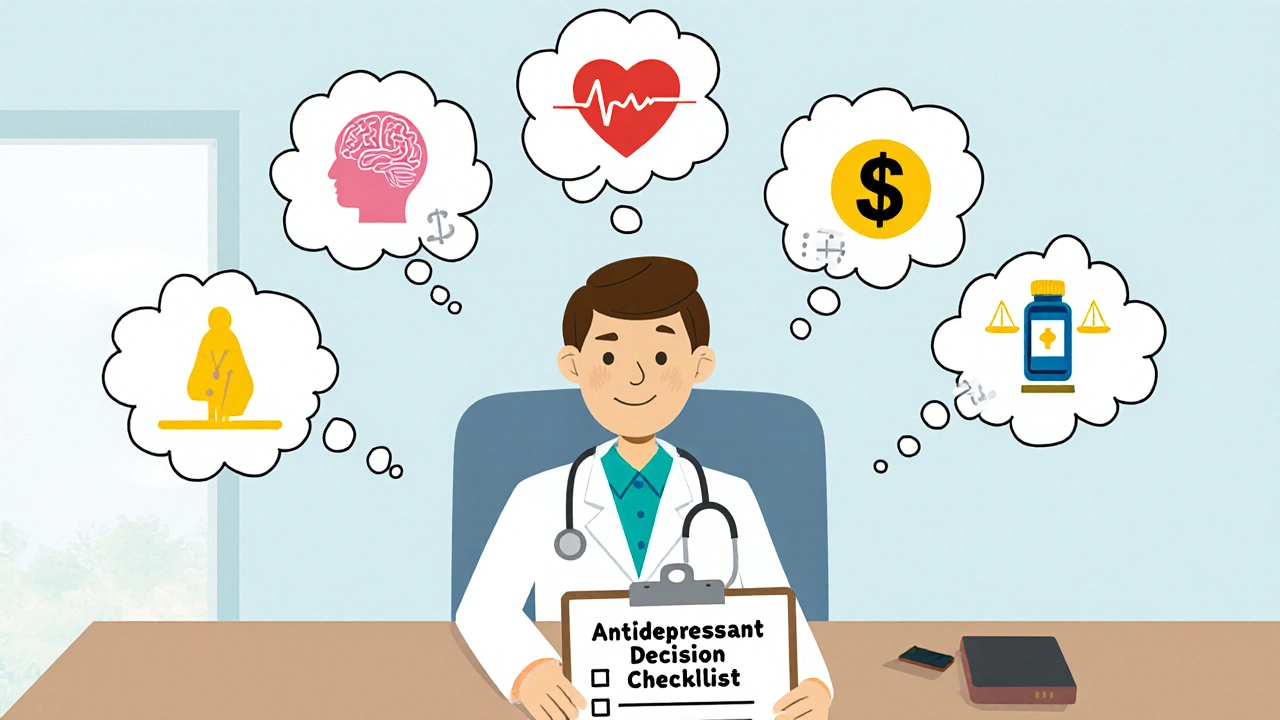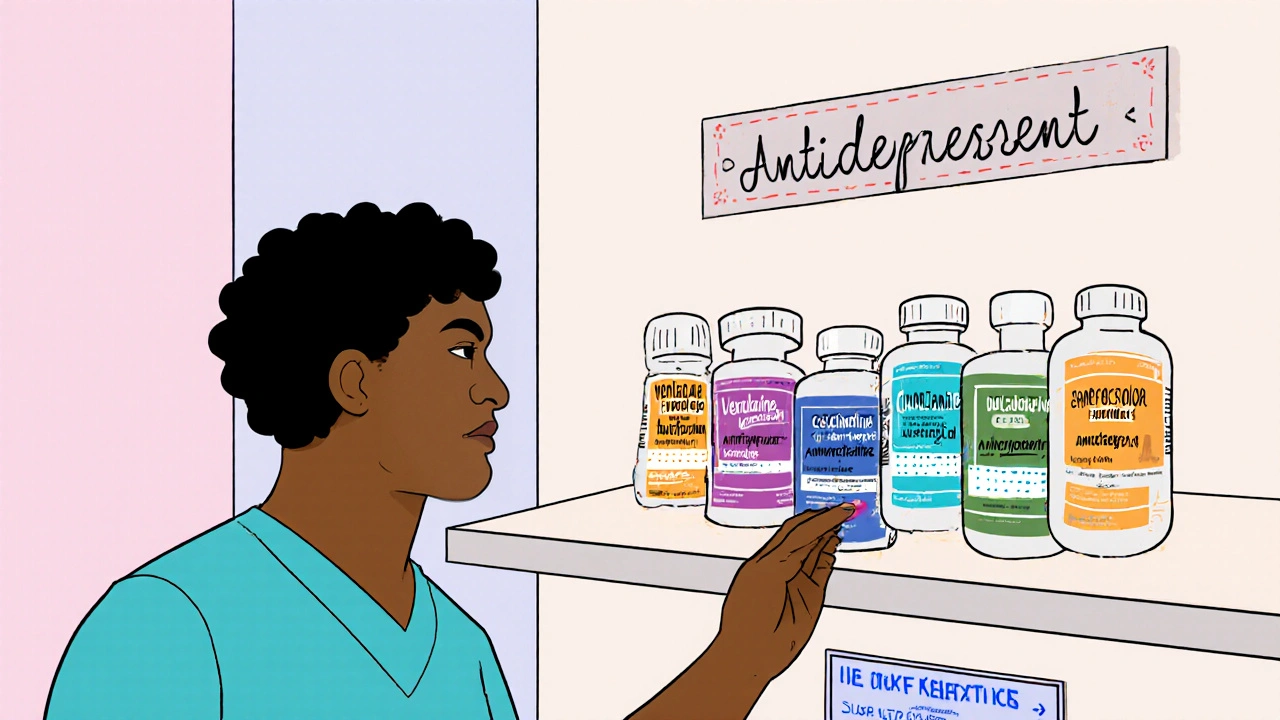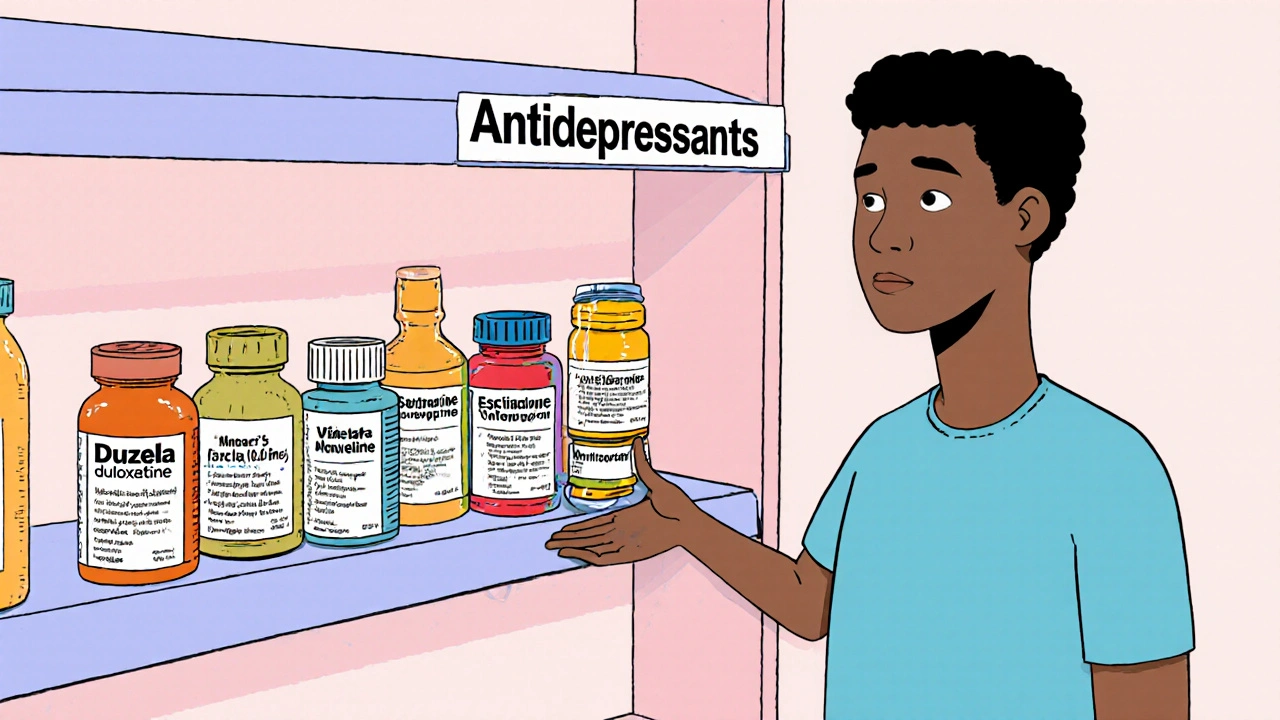Antidepressant Decision Guide
Which antidepressant might be right for you?
This tool helps you understand how different antidepressants compare based on your specific needs and medical profile. Answer a few questions to see personalized recommendations based on the latest clinical evidence.
Your Recommended Options
Quick Takeaways
- Both Duzela and its alternatives are FDA‑approved for major depressive disorder (MDD).
- Duloxetine (Duzela) also treats chronic musculoskeletal pain, giving it a dual‑use edge.
- Side‑effect profiles differ: duloxetine leans toward nausea and dry mouth, while SSRIs often cause sexual dysfunction.
- Onset of clinical effect is similar across most agents (2‑4 weeks), but milnacipran may feel faster for some patients.
- Cost varies widely; generic duloxetine is usually cheaper than brand‑only formulations of newer agents.
Choosing the right antidepressant can feel like shopping for a pair of shoes-comfort, fit, and price all matter. If you or a loved one have been prescribed Duzela vs other options, you need a clear side‑by‑side view of how duloxetine stacks up against the most common alternatives. This guide walks through the science, the side‑effects, the real‑world costs, and the patient‑type scenarios that tip the scales one way or another.
What is Duzela (duloxetine)?
When treating depression, Duzela is a brand name for the serotonin‑norepinephrine reuptake inhibitor duloxetine, approved for major depressive disorder and generalized anxiety disorder. Duloxetine works by increasing the levels of both serotonin and norepinephrine in the brain, which helps regulate mood, pain perception, and stress responses.
How duloxetine works
Duloxetine blocks the reuptake pumps for serotonin (5‑HT) and norepinephrine (NE). By keeping more of these neurotransmitters in the synaptic gap, it enhances signaling pathways that lift mood and dull pain signals. This dual‑action explains why Duzela is also FDA‑approved for diabetic peripheral neuropathy, fibromyalgia, and chronic musculoskeletal pain.
Key clinical uses
- Major Depressive Disorder (MDD) - first‑line treatment for adults.
- Generalized Anxiety Disorder (GAD) - effective for persistent worry.
- Chronic Pain Conditions - diabetic neuropathy, fibromyalgia, and chronic low‑back pain.
What to compare: Evaluation criteria
To make a fair choice, we’ll examine each drug across five practical dimensions:
- Efficacy - measured by remission rates in clinical trials.
- Side‑effect profile - the most common and the most troublesome.
- Onset of action - how quickly patients feel improvement.
- Dosage flexibility - range of strengths and titration ease.
- Cost & insurance coverage - average wholesale price and generic availability.
Common alternatives to duloxetine
Below are the most frequently prescribed antidepressants that clinicians consider when duloxetine isn’t the perfect fit.
Venlafaxine is another serotonin‑norepinephrine reuptake inhibitor (SNRI) whose brand names include Effexor XR; it’s known for a slightly stronger norepinephrine boost than duloxetine.
Sertraline is an SSRI (selective serotonin reuptake inhibitor) best known under the brand name Zoloft; it’s often the go‑to for patients who can’t tolerate norepinephrine effects.
Escitalopram is the S‑enantiomer of citalopram, sold as Lexapro; it offers a clean side‑effect profile with minimal weight gain.
Bupropion is a norepinephrine‑dopamine reuptake inhibitor (NDRI) marketed as Wellbutrin; it’s the only antidepressant not associated with sexual dysfunction.
Amitriptyline is a tricyclic antidepressant (TCA) that predates modern SSRIs and SNRIs, used for both mood and chronic pain.
Milnacipran is an SNRI approved mainly for fibromyalgia; it has a higher norepinephrine-to-serotonin ratio than duloxetine.
Side‑effect snapshots
Side‑effects often decide who stays on a drug. The table below condenses the most common complaints observed in large‑scale trials.
| Drug | Common Side‑effects | Less‑common but notable |
|---|---|---|
| Duloxetine (Duzela) | Nausea, dry mouth, insomnia, dizziness | Elevated blood pressure, liver enzyme changes |
| Venlafaxine | Nausea, headache, increased sweating | Hypertension (dose‑related), discontinuation syndrome |
| Sertraline | Diarrhea, sexual dysfunction, insomnia | Weight loss (early), QT prolongation (rare) |
| Escitalopram | Nausea, fatigue, sexual dysfunction | Serotonin syndrome (rare, with other serotonergics) |
| Bupropion | Dry mouth, insomnia, tremor | Seizure risk at high doses, hypertension |
| Amitriptyline | Dry mouth, constipation, drowsiness | Cardiac arrhythmia, orthostatic hypotension |
| Milnacipran | Nausea, headache, anxiety | Increased heart rate, elevated blood pressure |
Efficacy and onset
Head‑to‑head trials show that duloxetine, venlafaxine, and sertraline achieve remission rates around 30‑35 % after 8 weeks of treatment for moderate‑to‑severe MDD. Escitalopram and bupropion sit slightly lower (≈ 28 %). Amitriptyline’s efficacy is comparable but its side‑effect burden reduces adherence. Milnacipran excels only in fibromyalgia studies; its antidepressant effect is modest.
On average, patients notice mood improvement within 2‑4 weeks regardless of the agent. Those who need rapid pain relief often prefer duloxetine or milnacipran because the norepinephrine boost can dampen pain signals sooner.
Dosage flexibility
Duloxetine starts at 30 mg once daily, titrating to 60 mg or 120 mg for pain indications. Venlafaxine XR begins at 37.5 mg, moving up to 225 mg. Sertraline ranges 50‑200 mg, while escitalopram caps at 20 mg. Bupropion SR starts at 150 mg and can reach 450 mg daily. Amitriptyline doses vary widely (25‑150 mg) and require bedtime administration to avoid drowsiness.

Cost considerations (2025 U.S. market)
Average wholesale price (AWP) per month:
- Duloxetine (generic) - $20‑$30
- Venlafaxine XR (generic) - $15‑$25
- Sertraline - $4‑$12 (generic)
- Escitalopram - $6‑$12 (generic)
- Bupropion SR - $12‑$20
- Amitriptyline - $2‑$5
- Milnacipran - $150‑$200 (brand‑only)
Insurance plans commonly cover generic duloxetine, making it a cost‑effective dual‑indication option. The high price of milnacipran often pushes clinicians toward duloxetine for pain‑related depression.
Which drug fits which patient?
Duzela (duloxetine) shines for patients who need both mood and pain control, such as those with diabetic neuropathy or fibromyalgia. If sexual side‑effects are a major concern, bupropion may be a better first‑line choice. For a purely depressive picture with a low side‑effect threshold, sertraline or escitalopram are usually preferred. Patients with a history of cardiac arrhythmia should avoid amitriptyline and may favor duloxetine or an SSRI.
Practical checklist before starting
- Confirm diagnosis (MDD, GAD, pain condition).
- Screen for liver disease - duloxetine is metabolized by CYP1A2 and CYP2D6.
- Review current meds for potential serotonin syndrome risks.
- Discuss side‑effect priorities (e.g., weight, sexual function, blood pressure).
- Check insurance formulary for generics vs brand coverage.
- Set a follow‑up in 4‑6 weeks to assess efficacy and tolerability.
Bottom line
If you need a single pill that tackles both depression and chronic pain, Duzela is a strong candidate. If you’re more concerned about sexual dysfunction, weight gain, or high blood pressure, an SSRI or bupropion might be a smarter move. The comparison table and checklist above give you the data you need to talk confidently with your prescriber.

Is duloxetine effective for anxiety?
Yes. Duloxetine received FDA approval for generalized anxiety disorder in 2007. Clinical trials show a 30‑35 % remission rate, comparable to many SSRIs.
Can I switch from sertraline to Duzela?
Switching is possible but should be done under medical supervision. Typically, sertraline is tapered over 1‑2 weeks while duloxetine is introduced at a low dose (30 mg) to avoid serotonin syndrome.
What are the biggest drug‑interaction risks with duloxetine?
Duloxetine is metabolized by CYP1A2 and CYP2D6, so strong inhibitors (e.g., fluvoxamine, quinidine) can raise its levels. Combining with MAO‑inhibitors, other serotonergic agents, or NSAIDs increases bleeding and serotonin syndrome risk.
Is duloxetine safe during pregnancy?
Animal studies show no major teratogenic effect, but human data are limited. Most clinicians reserve duloxetine for pregnancy only when benefits outweigh potential risks.
How long should I stay on Duzela before evaluating success?
Give the medication at least 4‑6 weeks at a therapeutic dose before judging efficacy. If no improvement, discuss dose adjustment or switching with your doctor.







October 21, 2025 AT 00:06
When you think about medication choices, it helps to step back and see the bigger picture - health isn’t just a set of symptoms, it’s a lived experience. Duloxetine’s ability to ease both mood and pain can free someone from the constant battle between mind and body, which is a profound shift. That dual benefit often translates into better adherence, because you’re not juggling two separate pills. Keep in mind that personal values, cultural background, and daily routines all color how a drug feels in real life. So, if the prospect of a single solution resonates with your worldview, Duzela might just be the harmonious fit you’re searching for.